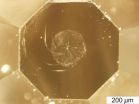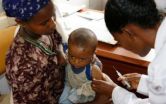(Press-News.org) Doctors have discovered that patients with a particular genetic variation are four times more likely to develop pancreatitis if they are prescribed a widely used group of drugs.
Clinicians at the Royal Devon and Exeter NHS Foundation Trust and the University of Exeter Medical School have discovered that 17 per cent of patients who have two copies of a particular genetic marker are likely to go on to develop pancreatitis if they are prescribed thiopurine drugs. The drugs, which include azathioprine and mercaptopurine, are some of the most effective and most commonly used drugs to suppress the immune system in the treatment of Inflammatory Bowel Disease (IBD), rheumatoid arthritis and after some organ transplants.
It has long been recognised that about four per cent of patients who are prescribed these drugs for IBD go on to develop pancreatitis, an inflammation of the pancreas, which can be fatal. But in a study published in Nature Genetics, doctors have identified a group of patients whose genetic make-up means they are more than four times more likely to develop the condition when given these drugs.
Dr Graham Heap was part of a team led by Dr Tariq Ahmad, a gastroenterologist at the Royal Devon & Exeter NHS Foundation Trust, working with the University of Exeter Medical School to coordinate input from over 150 hospitals around the world. Doctors around the UK and Europe, and as far afield as Canada and Australia sent genetic data on IBD patients who developed pancreatitis to allow the team to identify regions of the genome which could make people more susceptible to developing this serious drug side effect.
Dr Heap said: "Our collaboration, which involves clinicians around the world, is seeking to identify tests to enable doctors to predict which patients will develop serious drug side effects. We can now theoretically identify which patients could be at increased risk of developing pancreatitis. We are hoping that this test will be formed into a tool kit of DNA based tests that also assess other important side effects of these drugs such as liver damage or white blood cell counts. We would then be able to use this to identify at-risk patients and ultimately save lives."
INFORMATION:
The work has been funded by the International Serious Adverse Events Consortium, a not-for-profit organisation funded by pharmaceutical companies, the Wellcome Trust and academic institutions, which has a mission to find DNA variants which help explain why some patients suffer serious side effects from drugs. The Wellcome Trust also provided funding and Crohn's and Colitis UK supported the work.
The team found a genetic marker in the HLA area of the genome, which is associated with how the body responds to infection. People with two copies of the marker had a 17 per cent chance of developing pancreatitis after being given a thiopurine, while those with one copy had a nine per cent chance.
Dr Mike Weedon, of the University of Exeter Medical School, said the research was an excellent example of clinicians and scientists working together for the benefit of advancing better treatment. He said: "The future of healthcare innovation centres around science answering clinical need, and this international collaboration is a prime example of the partnership between researchers and clinicians proving invaluable."
Genetics reveals patients susceptible to drug-induced pancreatitis
Patients with a particular genetic variation are four times more likely to develop pancreatitis if they are prescribed thiopurine drugs
2014-09-15
ELSE PRESS RELEASES FROM THIS DATE:
Scientists come closer to the industrial synthesis of a material harder than diamond
2014-09-15
Researchers from Moscow Institute of Physics and Technology, Technological Institute for Superhard and Novel Carbon Materials in Troitsk, MISiS, and MSU have developed anew method for the synthesis of an ultrahard material that exceeds diamond in hardness. An article recently published in the journal Carbon describes in detail a method that allows for the synthesis of ultrahard fullerite, a polymer composed of fullerenes, or spherical molecules made of carbon atoms.
In their work, the scientists note that diamond hasn't been the hardest material for some time now. Natural ...
Nurses need education on advance health care directives, reports Journal of Christian Nursing
2014-09-15
September 15, 2014 – An educational program for nurses can help address knowledge gaps related to advance health care directives (AHCDs)—thus helping to ensure that patients' wishes for care at the end of life are known and respected, reports a paper in the October/December Journal of Christian Nursing, official journal of the Nurses Christian Fellowship. The journal is published by Lippincott Williams & Wilkins, a part of Wolters Kluwer Health.
Maureen Kroning, EdD, RN, of Nyack (N.Y.) College and Good Samaritan Hospital presents her hospital's experience with developing ...
Skin cancer risks higher for soldiers serving abroad
2014-09-15
Soldiers deployed to tropical and sunny climates are coming home with increased risk factors for a threat far from the battlefield: skin cancer.
In a retrospective study of about 200 veterans seen at the post-deployment clinic of the Tennessee Valley Healthcare System of the U.S. Department of Veterans Affairs, researchers from Vanderbilt University Medical Center and the Tennessee Valley Healthcare System found that 62 percent of military personnel reported getting sunburned while deployed abroad, including cases of skin blistering. In addition, 29 percent noted a change ...
The science behind swimming
2014-09-15
At nearly 100 feet long and weighing as much as 170 tons, the blue whale is the largest creature on the planet, and by far the heaviest living thing ever seen on Earth. So there's no way it could have anything in common with the tiniest fish larvae, which measure millimeters in length and tip the scales at a fraction of a gram, right?
Not so fast, says L. Mahadevan, the Lola England de Valpine Professor of Applied Mathematics, of Organismic and Evolutionary Biology, and of Physics.
Using simple hydrodynamics, a team of researchers led by Mahadevan was able to show ...
Brain Development in Schizophrenia Strays from the Normal Path
2014-09-15
Philadelphia, PA, September 15, 2014 – Schizophrenia is generally considered to be a disorder of brain development and it shares many risk factors, both genetic and environmental, with other neurodevelopmental disorders such as autism and intellectual disability.
The normal path for brain development is determined by the combined effects of a complex network of genes and a wide range of environmental factors.
However, longitudinal brain imaging studies in both healthy and patient populations are required in order to map the disturbances in brain structures as they emerge, ...
Sleep disorders widely undiagnosed in individuals with multiple sclerosis
2014-09-15
(SACRAMENTO, Calif.) —In what may be the largest study of sleep problems among individuals with multiple sclerosis (MS), researchers at UC Davis have found that widely undiagnosed sleep disorders may be at the root of the most common and disabling symptom of the disease: fatigue.
Conducted in over 2,300 individuals in Northern California with multiple sclerosis, the large, population-based study found that, overall, more than 70 percent of participants screened positive for one or more sleep disorders.
The research highlights the importance of diagnosing the root causes ...
How evolutionary principles could help save our world
2014-09-15
The age of the Anthropocene--the scientific name given to our current geologic age--is dominated by human impacts on our environment. A warming climate. Increased resistance of pathogens and pests. A swelling population. Coping with these modern global challenges requires application of what one might call a more-ancient principle: evolution.
That's the recommendation of a diverse group of researchers, in a paper published today in the online version of the journal Science. A majority of the nine authors on the paper have received funding from the National Science Foundation ...
Boosting armor for nuclear-waste eating microbes
2014-09-15
EAST LANSING, Mich. – A microbe developed to clean up nuclear waste and patented by a Michigan State University researcher has just been improved.
In earlier research, Gemma Reguera, MSU microbiologist, identified that Geobacter bacteria's tiny conductive hair-like appendages, or pili, did the yeoman's share of remediation. By increasing the strength of the pili nanowires, she improved their ability to clean up uranium and other toxic wastes.
In new research, published in the current issue of Applied and Environmental Microbiology, Reguera has added an additional layer ...
Selway complex and Johnson Bar fires in Idaho
2014-09-15
Two fires are seen burning in this satellite image taken by the Aqua satellite on September 11, 2014. The Selway complex of fires had been previously reported located 30 miles west of Darby, MT. It appears a new fire may have started again in this complex. Currently the size of the complex is 1,659 fires. The fire is mostly contained and there will be no additional reporting on this fire unless activity increases. It is, for the most part, contained.
The Johnson Bar fire started with a lightning strike on August 03, 2014. To date, 8,867 acres have been affected. ...
New glaucoma culprit is found
2014-09-15
Glaucoma, a leading cause of irreversible blindness, is associated with elevated pressure in the eye. This elevated pressure essentially is due to a plumbing problem. Fluid builds up in the eye, increasing pressure and eventually damaging the optic nerve. For nearly 150 years, researchers have been trying to understand what causes the blockage that prevents the eye from draining properly.
In a unique study of human ocular cells, a multi-institution research team led by a biomedical engineer at Northwestern University has found a new culprit. Glaucoma appears to be a consequence ...
LAST 30 PRESS RELEASES:
The perfect plastic? Plant-based, fully saltwater degradable, zero microplastics
Bias in data may be blocking AI’s potential to combat antibiotic resistance
Article-level metrics would provide more recognition to most researchers than journal-level metrics
Satiety’s little helper: Protein that supports appetite regulating protein identified
UF dives deep into predicting storm damage with computer models
A stormy ocean voyage yields insights on the global carbon cycle
Scientists identify first non-coding gene that controls cell size
Demonstration of altermagnetism in RuO₂ thin films -- A new magnetic material for the AI era
Penn researchers awarded $25M to conduct trial using smartphones to fight heart disease
PCORI awards funding for new patient-centered healthcare research
Exploring the origins of the universe: 145 low-noise amplifiers complete ALMA telescopes
Empress cicada wings help illuminate molecular structure
Using sound waves to detect helium
Time burden in patients with metastatic breast and ovarian cancer from clinic and home demands
Researchers discover bias in AI models that analyze pathology samples
Scientists ID potential way to prevent brain injuries from triggering Alzheimer's
MASTER 2nd Open Call: Execution period kick-off
Algae for health in food and pharma
Advanced microrobots driven by acoustic and magnetic fields for biomedical applications
Chicago health information leader recognized for raising CPR readiness and blood pressure awareness
The Intimate Animal, a new book from Kinsey Institute Executive Director Dr. Justin Garcia
When blue-collar workers lose union protection, they try self-employment
New video dataset to advance AI for health care
MEA-based graph deviation network for early autism syndrome signatures in human forebrain organoids
New modeling approach sheds light on rare gut disease
Study documents potentially hazardous flame retardants in firefighter gear
Can certain bacteria regulate aging of the immune system and its related alterations?
AI model helps diagnose often undetected heart disease from simple EKG
There are fewer online trolls than people think
Cell membrane fluctuations produce electricity
[Press-News.org] Genetics reveals patients susceptible to drug-induced pancreatitisPatients with a particular genetic variation are four times more likely to develop pancreatitis if they are prescribed thiopurine drugs



